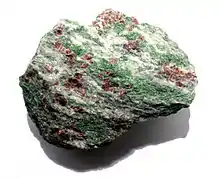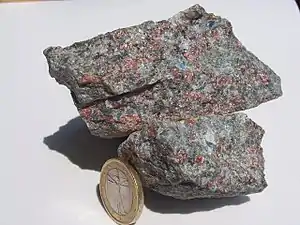Eclogite
Eclogite ( /ˈɛklədʒaɪt/) is a metamorphic rock formed when mafic igneous rock is subjected to high pressure. Eclogite forms at pressures greater than those typical of the crust of the Earth. An unusually dense rock, eclogite can play an important role in driving convection within the solid Earth.
The fresh rock can be striking in appearance, with red to pink garnet (almandine-pyrope) in a green matrix of sodium-rich pyroxene (omphacite). Accessory minerals include kyanite, rutile, quartz, lawsonite, coesite, amphibole, phengite, paragonite, zoisite, dolomite, corundum, and, rarely, diamond. Plagioclase is not stable in eclogite.
Origins
Eclogites typically result from high to ultrahigh pressure metamorphism of mafic rocks at low thermal gradients of <10 °C/km (29 °F/mi) as they were subducted to the lower crust to upper mantle depths in a subduction zone.[1] They are generally formed from precursor mineral assemblages typical of blueschist-facies metamorphism.
Eclogite facies
Eclogite facies is determined by the temperatures and pressures required to metamorphose basaltic rocks to an eclogite assemblage. The typical eclogite mineral assemblage is garnet (pyrope to almandine) plus clinopyroxene (omphacite).
Eclogites record pressures over 1.2 GPa (170,000 psi) (45 km (28 mi) depth) at about 400 to 1,000 °C (752 to 1,832 °F) and usually over 600–650 °C (1,112–1,202 °F). This is high-pressure, medium- to high-temperature metamorphism. Diamond and coesite occur as trace constituents in some eclogites and record particularly high pressures. Such ultrahigh-pressure (UHP) metamorphism has been defined as metamorphism within the eclogite facies but at pressures more than the quartz-coesite transition (the two minerals have the same composition—silica). Some UHP rocks appear to record burial at depths greater than 120 km (75 mi) if diamond occurs in these rocks.
Eclogites containing lawsonite (a hydrous calcium-aluminium silicate) are rarely exposed at Earth's surface, although they are predicted from experiments and thermal models to form during normal subduction of oceanic crust at depths between about 45–300 km (28–186 mi).[2] The rarity of lawsonite eclogites therefore does not reflect unusual formation conditions but unusual exhumation processes. Lawsonite eclogite is known from the U.S. (Franciscan Complex of California; xenoliths in Arizona); Guatemala (Motagua fault zone), Corsica, Australia, the Dominican Republic, Canada (British Columbia), and Turkey.
Eclogite is the highest pressure metamorphic facies and is usually the result of advancement from blueschist metamorphic conditions.
Importance of eclogite

Eclogite is a rare and important rock because it is formed only by conditions typically found in the mantle or the lowermost part of thickened crust.
Eclogites are helpful in elucidating patterns and processes of plate tectonics because many represent the crustal rocks that were subducted to depths in excess of 35 km and then returned to the surface.
Eclogite that is brought to shallow conditions is unstable, and retrograde metamorphism often occurs: secondary amphibole and plagioclase may form reaction rims on the primary pyroxene or garnet, and titanite may form rims about rutile. Eclogite may completely retrogress to amphibolite or granulite during exhumation. In some retrogressed eclogites and accompanying more silica-rich rocks, ultrahigh-pressure (UHP) metamorphism has been recognized only because of the preservation of coesite and/or diamond inclusions within trace minerals such as zircon and titanite.
Xenoliths of eclogite occur in kimberlite pipes of Africa, Russia, Canada, and elsewhere. Eclogites in granulite terranes are known from the Musgrave Block of central Australia where a continental collision took place at 550-530 Ma, resulting in burial of rocks to greater than 45 km (15 kilobars) and rapid (in less than 10 million years) exhumation via thrust faults prevented significant melting. Felsic rocks in these terranes contain sillimanite, kyanite, coesite, orthoclase and pyroxene, and are rare, peculiar rocks formed by an unusual tectonic event.
Formation of igneous rocks from eclogite

Peridotite is the dominant rock type of the upper mantle, not eclogite, as established by seismic and petrologic evidence. Likewise, peridotite is a much more important source rock of common magmas.
Melting of eclogite to produce basalt directly is generally not supported in modern petrology. Unreasonably high degrees of partial melting are required to attain basaltic compositions. To get a basalt from melting an eclogite (i.e.; a rock with basalt composition) it has to undergo 100% partial melting. Instead, basalts can be modelled as having been produced by 1 to 25% partial melting of peridotite, such as harzburgite and lherzolite. Some andesite-like rocks could be produced from partial melting of eclogite; for instance, an unusual rock type called adakite (first described from Adak Island in the Aleutians) has been proposed to be a product of partial melting of eclogite in subducting oceanic crust. Likewise, partial melting of eclogite has been modeled to produce tonalite-trondhjemite-granodiorite melts.[3]
Basalt is generally created as a partial melt of peridotite at 20–120 km depth. Eclogite is denser than the surrounding asthenosphere. Unless the eclogite is created in very young oceanic crust, it is cool at the time of initial subduction and so is carried down into the mantle. If that subducted eclogite is subsequently carried upward with peridotite, as in a mantle plume, it may melt by decompression melting (see discussion in igneous rock) at lower temperature than the accompanying peridotite. Eclogite-derived melts may be common in the mantle, and contribute to volcanic regions where unusually large volumes of magma are erupted.[4]
The eclogite melt may then react with enclosing peridotite to produce pyroxenite, which in turn melts to produce basalt.[5]
Eclogite diamonds
Many diamonds from eclogite xenoliths have a 13C:12C isotope ratio different from that typical of diamonds from peridotite xenoliths. The carbon isotopic differences between harzburgitic and eclogitic diamonds supports the hypothesis that those eclogite xenoliths formed from basalt carried down within subduction zones.
Eclogite diamonds are also typically higher in nitrogen, and will have a different suite of mineral inclusions than harzburgitic diamonds. Harzburgitic diamonds typically have titaniferous pyrope, chromian spinel and chromian diopside inclusions, minerals which are not typically found in eclogites.
Distribution

Eclogites occur with garnet peridotites in Greenland and in other ophiolite complexes. Examples are known in Saxony, Bavaria, Carinthia, Norway and Newfoundland. A few eclogites also occur in the northwest highlands of Scotland and the Massif Central of France. Glaucophane-eclogites occur in Italy and the Pennine Alps. Occurrences exist in western North America, including the southwest[6] and the Franciscan Formation of the California Coast Ranges.[7] Transitional granulite-eclogite facies granitoid, felsic volcanics, mafic rocks and granulites occur in the Musgrave Block of the Petermann Orogeny, central Australia. Coesite- and glaucophane-bearing eclogites have been found in the northwestern Himalaya.[8] The oldest coesite-bearing eclogites are about 650 and 620 million years old and they are located in Brazil and Mali, respectively.[9][10]
References
- Zheng, Yong-Fei; Chen, Ren-Xu (September 2017). "Regional metamorphism at extreme conditions: Implications for orogeny at convergent plate margins". Journal of Asian Earth Sciences. 145: 46–73. Bibcode:2017JAESc.145...46Z. doi:10.1016/j.jseaes.2017.03.009. ISSN 1367-9120.
- Hacker, Bradley R. (2008). "H2O subduction beyond arcs" (PDF). Geochemistry, Geophysics, Geosystems. 9 (3). Bibcode:2008GGG.....9.3001H. CiteSeerX 10.1.1.513.829. doi:10.1029/2007GC001707.
- Rapp, Robert P.; Shimizu, Nobumichi; Norman, Marc D. (2003). "Growth of early continental crust by partial melting of eclogite". Nature. 425 (6958): 605–609. Bibcode:2003Natur.425..605R. doi:10.1038/nature02031. PMID 14534583.
- Foulger, G.R. (2010). Plates vs. Plumes: A Geological Controversy. Wiley-Blackwell. ISBN 978-1-4051-6148-0.
- Sobolev, Alexander V.; Hofmann, Albrecht W.; Sobolev, Stephan V.; Nikogosian, Igor K. (March 2005). "An olivine-free mantle source of Hawaiian shield basalts". Nature. 434 (7033): 590–597. Bibcode:2005Natur.434..590S. doi:10.1038/nature03411. ISSN 0028-0836. PMID 15800614.
- William Alexander Deer, R. A. Howie and J. Zussman (1997) Rock-forming Minerals, Geological Society, 668 pages ISBN 1-897799-85-3
- C. Michael Hogan (2008) Ring Mountain, The Megalithic Portal, ed. Andy Burnham
- Wilke, Franziska D.H.; O'Brien, Patrick J.; Altenberger, Uwe; Konrad-Schmolke, Matthias; Khan, M. Ahmed (January 2010). "Multi-stage reaction history in different eclogite types from the Pakistan Himalaya and implications for exhumation processes". Lithos. 114 (1–2): 70–85. Bibcode:2010Litho.114...70W. doi:10.1016/j.lithos.2009.07.015.
- Jahn, Bor-ming; Caby, Renaud; Monie, Patrick (2001). "The oldest UHP eclogites of the World: age of UHP metamorphism, nature of protoliths and tectonic implications". Chemical Geology. 178 (1–4): 143–158. Bibcode:2001ChGeo.178..143J. doi:10.1016/S0009-2541(01)00264-9.
- Santos, Ticiano José Saraiva; Amaral, Wagner Silva; Ancelmi, Matheus Fernando; Pitarello, Michele Zorzetti; Fuck, Reinhardt Adolfo; Dantas, Elton Luiz (2015). "U–Pb age of the coesite-bearing eclogite from NW Borborema Province, NE Brazil: Implications for western Gondwana assembly". Gondwana Research. 28 (3): 1183–1196. Bibcode:2015GondR..28.1183D. doi:10.1016/j.gr.2014.09.013.
- Harvey Blatt and Robert Tracy, 1995, Petrology: igneous, sedimentary, and metamorphic, Freeman, ISBN 0-7167-2438-3
- A. Camacho, B.J. Hensen and R. Armstrong, Isotopic test of a thermally driven intraplate orogenic model, Australia', Geology, 30, pp. 887–890
External links
| Wikimedia Commons has media related to Eclogite. |
